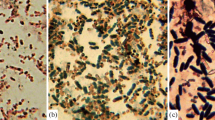Summary
Experiments carried out in a sand culture have demonstrated that during the growth ofVicia faba andLupinus luteus inoculated with effective strains of Rhizobium, and when the behaviour of bacteroids isolated from nodules ofLupinus luteus, Pisum sativum andVicia faba which had been inoculated with effective and ineffective strains and when comparisons were made between bacteriods isolated from effective nodules ofVicia faba andLupinus luteus either at midday or at midnight there is a reverse correlation between the intensity of nitrogen fixation and respiration, on the one hand, and the content of poly-β-hydroxybutyric acid (PHB), on the other. This evidence suggests an important role played by PHB in the supply of symbiotic fixation with energy and carbon substrates.
Glucose and β-hydroxybutyrate were the best substrates for PHB synthesis in the suspension of bacteroids of an effective strain ofR. lupini at all stages of plant growth. At the stage of active nitrogen fixation (flowering) PHB was actively synthesized in the presence of succinate. In the absence of exogenous substrates the polymer degraded, the process being enhanced in the presence of ammonium ions. When ammonium was added together with glucose, PHB synthesis did not occur and at the flowering stage the polymer broke down particularly rapidly. re]19760505
Similar content being viewed by others
References
Bergersen, F. J., The bacterial component of soybean root nodules; changes in respiratory activity, cell dry weight and nucleic acid content with increasing nodule age. J. Gen. Microbiol. 19, 312–323 (1958).
Bergersen, F. J., Biochemistry of symbiotic nitrogen fixation in legumes. Annu. Rev. Plant Physiol. 22, 121 (1971).
Dawes, E. A. and Senior, P. J., The role and regulation of energy reserve polymers in microorganisms. Adv. Microb. Physiol. 10, 135 (1973).
Forsyth, W. G. C., Hayword, A. C. and Roberts, J. B., Occurrence of poly-β-hydroxybutyric acid in aerobic gram-negative bacteria. Nature London 182, 800 (1958).
Hardy, W. F., Holsten, R. D., Jackson, E. K. and Burns, R. C., The acetylene-ethylene assay for N2 fixation: Laboratory and field evaluation. Plant Physiol. 43, 1185 (1968).
Klucas, R. V., Studies on soybean nodule senescence. Plant Physiol. 54, 612 (1974).
Klucas, R. V. and Evans, H. J., An electron donor system for nitrogenase — dependent acetylene reduction by extracts of soybean nodules. Plant Physiol. 43, 1458 (1968).
Kretovich, W. L., Nitrogen Metabolism in Plants. ‘Nauka’, Moscow (1972).
Kretovich, W. L., Matus, V. K. and Melik-Sarkisyan, S. S., Cytochromes and the respiration rate of root nodule lupin bacteriods in the course of plant vegetation. Plant Physiol. Moscow 19, 1060 (1972).
Kretovich, W. L., Romanov, V. I. and Korolyov, A. V.,Rhizobium leguminosarum Cytochromes (Vicia faba). Plant and Soil 39, 619 (1973).
Law, J. M. and Slepecky, R. A., Assay of poly-β-hydroxybutyric acid. J. Bacteriol. 82, 33–36 (1961).
Lvov, N. P., Sergeev, N. S., Veinova, M. K., Shaposhnikov, G. L. and Kretovich, W. L., Regulatory role of ammonium in the reduction of nitrogen and acetylene by extracts fromAz. vinelandii. DAN, 201, 1493 (1971).
Schlegel, H. G., Die Isolierung von Poly-β-hydroxybuttersäure aus Wuzzel-knöllchen von Leguminosen. Flora 152, 236–239 (1962).
Schlegel, H. G., Gottschalk, G. and vonBartha, R., Formation and utilization of poly-β-hydroxybutyric acid by knallgas bacteria (Hydrogenomonas). Nature London 191, 463, (1961).
Senior, P. I., Beech, G. A., Ritchie, G. A. F. and Dawes, E. A., The role of oxygen limitation in the formation of poly-β- oxybutyrate during batch and continuous culture ofAzotobacter bejerinckii. Biochem. J. 128, 1193–1201 (1972).
Shaposhnikov, G. L., Evstigneeva, Z. G., Aseeva, K. B. and Kretovich, W. L., Diurnal variation in the intensity of molecular nitrogen fixation, content of free amino acids and ammonium in lupine nodules. Plant Physiol. Moscow 22, 786 (1975).
Sholz, H. F. and Ostrowsky, D. N., Polarographic cell with a closed platinum electrode. Lab. Delo 6, 375 (1965).
Stanier, R. Y., Doudoroff, M., Kumisava, R. and Contopoulou, R., The role of organic substrates in bacterial photosynthesis. Proc. Nat. Acad. Sci. U.S. 45, 1246–1260 (1959).
Vanderholf, L. N., Leibson, P. J., Musil, R. J., Huang-Chi-Ying, Fiehweg, R. E., Williams, J. W., Wackwitz, D. L. and Mason, K. T., Diurnal variation in algal acetylene reduction (nitrogen fixation)in situ. Plant Physiol. 55, 273–276 (1975).
Ward, A. C. and Dawes, E. A., A disc assay for poly-β-hydroxybutyrate. Anal. Biochem. 52, 607–613 (1973).
Wong, P. P. and Evans, H. J., Poly-β-hydroxybutyrate utilization by soybean (Glycine max Merr) nodules and assessment of its role in maintenance of nitrogenase activity. Plant Physiol. 47, 750–755 (1971).
Author information
Authors and Affiliations
Rights and permissions
About this article
Cite this article
Kretovich, W.L., Romanov, V.I., Yushkova, L.A. et al. Nitrogen fixation and poly-β-hydroxybutyric acid content in bacteroids ofRhizobium lupini andRhizobium leguminosarum . Plant Soil 48, 291–302 (1977). https://doi.org/10.1007/BF02187241
Received:
Issue Date:
DOI: https://doi.org/10.1007/BF02187241




